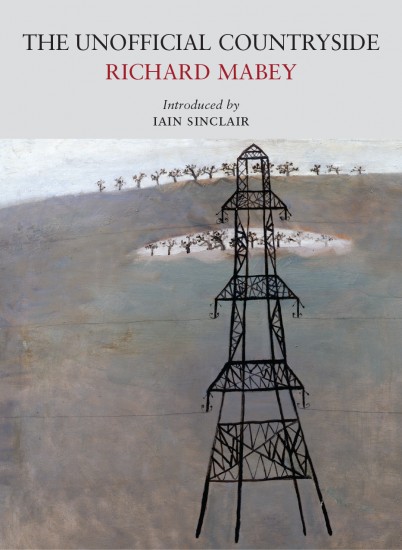
Richard Mabey, The Unofficial Countryside, Introduction by Iain Sinclair, Little Toller Books, £10.
review by Ken Worpole.
This delightful reprint restores to public attention Richard Mabey’s pioneering study of urban and fringe nature, first published in 1973. It also comes with a characteristically left-field introduction by Iain Sinclair who twins this book with J.G.Ballard’s Concrete Island (1974) as amongst the key texts of late 20th century English urban neo-romanticism. Having Sinclair write the introduction effects a decisive historical rendezvous – long-awaited – between the very rich and strong tradition of English nature-writing and the post-Situationist energy field of metropolitan psycho-geography. Not surprisingly they meet on the edge. For it was Mabey’s inventiveness which led him to explore the unexpected bio-diversity of the urban fringe, amongst the railway goods yards, sewage farm curtileges, canal towpaths, allotments, and disused factory wastelands, which more traditional naturalists eschewed. As Mabey was early to suggest, the concepts of ‘urban’ and ‘rural’ no longer apply, and ‘it is not the parks but the railways sidings which are thick with wild flowers’. This was counter-intuitive at the time, though happily it has become the new common sense. In a similar vein it was the allure of dereliction and the ache of industrial memory which attracted Sinclair and others to the same territory around the same time. Psycho-geography met chaos theory here, whereby a butterfly which flapped its wings at Tottenham Lock, could somehow be connected to the poll-tax riots in Trafalgar Square.
The Unofficial Countryside is divided into four sections: Spring, Summer, Autumn and Winter. A lot of the early part of the book is devoted to challenging the conventional distinctions between flowers and weeds, between native and imported species (birds respect no national boundaries), and between formal and informal landscapes. The title clearly echoes Rupert Brooke’s evocation of ‘an English unofficial rose’, and Mabey certainly has it in for municipal parks, which he regards as a kind of black hole in the natural world. Quite quickly this book changed attitudes, and some of those changes can now be seen not only in the massive improvement in parks and formal landscapes in British towns and cities today, but also in the proliferation of urban and semi-urban wildlife sanctuaries. Towards the end of his account, Mabey and a group of professional botanists go foraging near the landfill sites (or rubbish tips as they used to be called) close to the Thames near Dagenham. All kinds of species are found. Today they would also be able to visit the adjacent RSPB site at Rainham Marshes, now an ecological idyll. All the way downriver, these marginal, polluted lands are being turned into successful natural reserves. Canvey Wick, for example, is now called ‘England’s little brown rainforest’, and it is claimed supports more bio-diversity per square foot than any other wildlife site in the UK.
Mabey concludes with a visit to the reservoirs in Stoke Newington, circa 1972, which by mid-winter ‘often have a higher density of wildfowl than any other inland waters in the South of England.’ However, he is prevented from entering the site and watching the birds by strict Metropolitan Water Board prohibition. If he were to return now he would find the reservoirs intact, in public hands, and used for teaching local school-children to canoe and use sailing boats. There is also a dedicated website devoted to recording all the birds which visit the reservoirs throughout the year. It is a genuine public amenity, and represents an aspect of urban life which has improved immeasurably with the years (and is less than 200 yards from where I am sitting at a computer writing this). It’s not all downhill by any means, and a lot is owed to books like this which first alerted people to the ecological delights which have found a niche in the back territories of the ever-changing city.
Ken Worpole (www.worpole.net) is the author of a number of books on architecture, landscape and social policy. His book with photographer Jason Orton, 350 Miles, is a big favourite of Caught by the River and we have a handful of copies left for sale in our shop.
Copies of The Unofficial Countryside are on sale in the Caught by the River shop, priced £10.